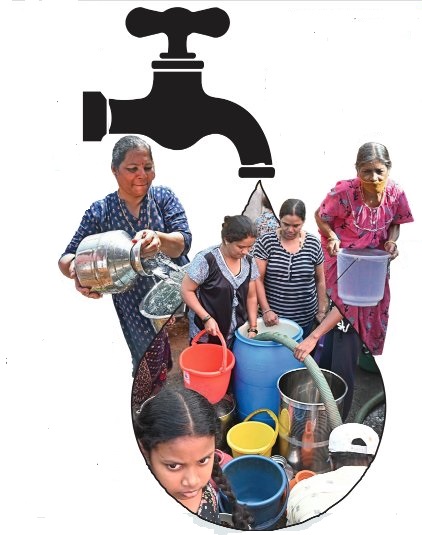
MAPUSA
In a world where water is a basic necessity, even a day’s disruption in supply can cause an uproar among citizens.
This reality has become all too familiar for the coastal villages of Siolim and Calangute in Bardez, where the issue of irregular water supply has plagued residents for years. The situation worsens during the scorching summer months, as water levels in reservoirs dip, forcing authorities to restrict supply, leaving many areas dry and residents frustrated.
For villages at the tail-end of water supply systems, this has become a perennial problem. Communities like Anjuna, Vagator, Assagao, Gudem in Siolim constituency, and Arpora, Candolim, and Calangute in Calangute constituency are among the worst affected. These villages experience acute water shortages, particularly during the summer season, making daily life an arduous struggle for locals.
PROTESTS, PLEAS FALL ON DEAF EARS
Desperate for water, residents have taken to the streets in protest. In Siolim and Calangute, morchas have been organised, with locals marching to PWD offices, demanding action. Yet, the grievances seem to fall on deaf ears.
Pradeep Harmalkar, a resident of Anjuna, voiced the shared frustration: “This is a recurring nightmare in Anjuna. For years, we've endured inadequate water supply, but the situation worsens come summer.”
The issue, however, is not confined to the summer. Villages in higher-altitude areas suffer particularly, as noted by Assagao Sarpanch Hanumant Naik, who admits that the problem is discussed at nearly every gram sabha. "We have written letters and met engineers on multiple occasions, but the situation doesn’t improve. It’s incredibly frustrating to fight for something as basic as water," he remarked.
SHORT-LIVED FIX, TANKER CRISIS
Interestingly, whenever the issue is raised publicly or through protests, water supply is temporarily restored. However, after a day or two, the situation reverts to irregular supply, leaving residents back where they started.
Nilesh Vernekar, a resident of Siolim, expressed his frustration, stating, "We have been facing this water scarcity for years, but the government has been turning a blind eye to our problems."
With no other option, many residents have turned to private water tankers to meet their daily needs. But this comes with its own set of problems.
Exploiting the scarcity, tanker contractors tap into illegal bore-wells, selling water at exorbitant prices to both desperate households and commercial establishments. "It’s a goldmine for those in the tanker business. They tap into illegal sources and supply water to the highest bidder while authorities turn a blind eye," said Ramesh Naik, chairman of the Anjuna Biodiversity Committee.
OVERBURDENED WATER TREATMENT PLANT
One of the primary causes of the water crisis is the inability of the Assonora water treatment plant to meet the growing demand. The plant, which serves the entire Bardez taluka, struggles to provide adequate supply, particularly during peak tourist seasons.
As Premanand Diukar, a resident of Calangute, explained, “Earlier we used to face water problems only during festivals like Ganesh Chaturthi. This year, the flow was somewhat consistent, but that doesn’t mean everything is fine.”
Some wards, such as Umtavaddo, Khobravaddo, and Saunthavaddo in Calangute, have historically faced severe water shortages, with the situation showing little sign of improvement.
BOOMING TOURISM, OUTDATED INFRASTRUCTURE
Two main factors exacerbate the water crisis in these coastal villages: a booming tourism industry and an ageing infrastructure. The surge in construction, driven by the demand for hotels, guest-houses, and holiday homes, has placed an immense strain on the water supply.
Real estate development has led to an explosion in the number of buildings, from luxury villas to sprawling hotels, without a corresponding increase in water supply infrastructure.
“Imagine permission being granted for five bungalows, each with its own swimming pool. Where will the water come from?” questioned Michael D’Souza, an Anjuna resident who has spent the last five years fighting for reliable water access.
His question underscores a larger concern – rapid construction has outpaced the capacity of the existing water infrastructure, leaving local residents to bear the brunt of the crisis.
The situation is similar in Vagator, where resident Parvathi Nagvenkar has witnessed the population surge alongside the rise of new hotels and villas. “The authorities need to double their efforts to keep up with the times. Our population has increased, but the infrastructure remains stuck in the past. We cannot rely on old pipelines and water tanks,” said Nagvenkar, who has led several protests, including a recent demonstration at the PWD office in Mapusa.
INFRA STUCK IN THE PAST
Many water supply pipelines in Siolim and Calangute were installed decades ago, when the population and water demand were far lower. According to Nilesh Vernekar, the pipeline that serves Siolim was built over 40 years ago, meant to cater to about 150 houses.
Today, that number has doubled, yet the same ageing pipeline continues to serve nearly 300 households, creating immense pressure on an already strained system. "The infrastructure is old and crumbling, yet no significant upgrades have been made," said Vernekar.
The outdated pipelines are not only insufficient to meet the growing demand but also prone to frequent leaks and breakdowns, compounding the issue of irregular supply.
THE WAY FORWARD
The water crisis in Siolim and Calangute is not just an issue of scarcity but one of planning and governance. As tourism continues to boom and construction activity soars, the demand for water will only increase. Without a corresponding investment in infrastructure, the problem will persist, leaving locals and businesses alike struggling to cope.
For residents like Pradeep Harmalkar and Michael D’Souza, the fight for regular water supply is far from over. “We are not asking for luxuries. We just want access to a basic necessity,” said D’Souza.
The question now is whether the government and local authorities will finally heed the call and take decisive action before the situation worsens. For now, the coastal villages remain parched, waiting for a solution that seems long overdue.